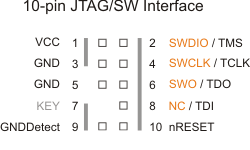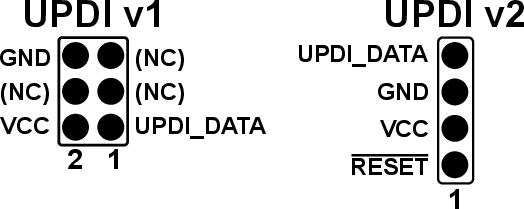04 Embedded Programming
- audiobook of data sheet ATtiny212_412
- recitation
- presentation
- literature explaining working with AVRs
- microcontroller vs -processor
- download platformio for vscode
MCU
An MCU is a group of microcontroller units that share a common architecture, design, and often the same core features - ARM Cortex-M is a popular MCU family, where multiple manufacturers like STMicroelectronics, NXP, and Microchip produce MCUs that are based on the ARM Cortex-M core. - AVR is another MCU family, famously used in the Arduino platform. - PIC is a family of MCUs from Microchip Technology, with a range of devices from small 8-bit controllers to more powerful 16-bit and 32-bit versions.
Within each MCU family, you’ll typically see models that differ by features like: - Flash memory size - RAM size - Clock speed - Number of GPIO pins - Peripheral support (e.g., UART, SPI, I2C, timers, etc.)
In-System Programming (ISP) - the act of programming a microcontroller while it is already mounted on the board - Contrary to Pre-Programming. You program the contro
CMSIS-DAP Devices are all devices that can write programs into a microcontroller's memory using JTAG or SWD. ler before soldering it somewhere.
Available Controllers
At least 5 of each:
- SEEEDSTUDIO XIAO SAMD21 NO HDRS
- SEEEDSTUDIO XIAO ESP32C3 NO HDRS
- SEEEDSTUDIO XIAO ESP32S3 NO HDRS
- SEEED STUDIO XIAO RP2040 ARDUINO
- ATSAMD11C14A-SSUT
- ATSAMD21E18A-AUT
- ATTINY412-SSFR
- ATTINY1624-SSFR
- ATTINY3226-SU
- AVR128DB32-I/PT
| Xiao RP2040 | Pico RP2040 | ESP32C3 | ESP32S3 | SAMD21 | ATSAMD11C14A-SSUT | ATSAMD21E18A-AUT | ATTINY412-SSFR | ATTINY1624-SSFR | ATTINY3226-SU | AVR128DB32-I/PT | |
|---|---|---|---|---|---|---|---|---|---|---|---|
| Type | ARM Cortex M0+ 32Bit | ARM Cortex M0+ 32Bit | ESP-RISC-V 32Bit | Xtensa® 32-bit LX7 | ARM-Cortex M0+ 32Bit | ARM Cortex-M0+ 32Bit | ARM Cortex M0+ 32Bit | AVR® RISC 8-bit | AVR® RISC 8-bit | AVR® RISC 8-bit | AVR® RISC 8-bit |
| Frequency | 133MHz | 133MHz | 160 MHz | 240 MHz | 48MHz | 48MHz | 48MHz | 20MHz | 20MHz | 20MHz | 24MHz |
| SRAM | 264KB | 264KB | 400 KB | 8MB | 32KB | 4KB | 32KB | 256B | 2KB | 3KB | 16KB |
| onboard memory | 2MB | 2MB | 4MB | 8MB | 256KB | 16KB | 256KB | 4KB | 16KB | 32KB | 128KB |
| I/O-Pins | 11 | 26 | 11 | 11 | 11 | 12 | 26 | 6 | 12 | 18 | 25/26 (1x only In) |
| ADC | 4 | 3 | 3 | 9 | 11 | 5 | 6 | 6 | 9 | 15 | 13 |
| DAC | 0 | 0 | 0 | 0 | 1 | 1 | 1 | 1 | 0 | 0 | 1 |
| Package | SOIC-14 | TQFP-32 | SOIC-8 | SOIC-14 | SOIC-20 | TQFP-32 | |||||
| Price | 4,68 $ | 5 $ | 4,99 $ | 7,49 $ | 5,4 $ | 1,58 $ | 4,03 $ | 0,59 $ | 1,01 $ | 1,29 $ | 2,06 $ |
| FPU available? |
RP2040 (Raspberry Pi Pico)
Toolchain:
- Primary: Pico SDK (C/C++), CMake
- Alternatives: Arduino IDE (via Arduino-Pico Core), MicroPython/CircuitPython
Workflow:
1. Write code in C/C++ or Python.
2. Build with CMake (Pico SDK) or Arduino IDE.
3. Flash via USB (UF2 bootloader) or SWD debugger (e.g., Picoprobe).
Efficiency Tips:
- Use Visual Studio Code with the Pico SDK extension for CMake integration.
- Leverage Picoprobe (a second Pico) for debugging.
ESP32 (Espressif)
Toolchain:
- Primary: ESP-IDF (C/C++), PlatformIO
- Alternatives: Arduino IDE (via ESP32 Core)
Workflow:
1. Develop in C/C++ (ESP-IDF) or Arduino framework.
2. Build with ESP-IDF CLI or PlatformIO.
3. Flash via USB (esptool.py) or OTA updates.
Efficiency Tips:
- PlatformIO streamlines ESP-IDF/Arduino workflows.
- Use ESP-Prog or JTAG for advanced debugging.
SAMD21/SAMD11 (Atmel/Microchip)
Toolchain:
- Primary: Atmel/Microchip Studio (C/C++)
- Alternatives: Arduino IDE (via SAMD Core)
Workflow:
1. Code in C/C++ (Microchip Studio) or Arduino.
2. Build and flash via USB (UF2 bootloader) or EDBG/SWD.
Efficiency Tips:
- Use Arduino IDE for simplicity; enable verbose upload for debugging.
- For low-level control, use CMSIS libraries in Microchip Studio.
Attiny/AVR128 (AVR Family)
Toolchain:
- Primary: AVR-GCC + AVRdude
- Alternatives: Arduino IDE (via ATTiny Core)
Workflow:
1. Write code in C/C++ or Arduino.
2. Compile with AVR-GCC or Arduino IDE.
3. Flash via ISP programmer (e.g., USBasp, Arduino-as-ISP).
Efficiency Tips:
- Use PlatformIO for project management.
- For tinyAVR (e.g., ATtiny85), optimize code size with -Os compiler flag.
General Workflow Optimization Tips
- Unified Environments:
- PlatformIO (VS Code) supports all listed MCUs, reducing toolchain setup time.
-
Arduino IDE (with board managers) simplifies entry-level development.
-
Debugging Tools:
- SWD/JTAG: Use for RP2040, ESP32, SAMD21 (e.g., Segger J-Link, CMSIS-DAP).
-
Serial Monitor: Essential for ESP32/RP2040 debugging.
-
Version Control:
-
Use
gitfor code management; track dependencies (e.g., submodules for Pico SDK). -
Automation:
- Write Makefiles or use PlatformIO scripts for CI/CD pipelines.
QFP mit Beinchen seitlich
TQFP ohne Beinchen
Soic-8 8 Beinchen
Punkt oder Kerbe kennzeichnen Pin 1
Putting code onto it
In-System Programming (ISP) - the act of programming a microcontroller while it is already mounted on the board - Contrary to Pre-Programming. You program the contro
CMSIS-DAP Devices are all devices that can write programs into a microcontroller's memory using JTAG or SWD. ler before soldering it somewhere.
Serial Peripheral Interface (SPI) - A standard synchronous serial communication interface used for short-distance communication between a main device and one or more peripheral devices. - synchronous (needs clock signal), serial communication - multiple secondary devices are possible - full-duplex - pins: - MOSI (main out secondary in) - MISO (main in secondary out) - SCK (clock) - SS (secondary select): select which secondary device to communicate with
Serial Peripheral Data Interface (SPDI) - do not find any source for it - Good Article GERMAN
Joint Test Action Group (JTAG) - eletronics manufacturers committee - they developed a protocol with the same name - mostly used for programming ARM cores - daisy-chaining possible - pins - TMS: mode select - TCLK: clock - TDO: data out - TDI: data in - nRESET: reset (optional)

Serial Wire Debug (SWD) - two-pin variant of the JTAG protocol -> replaced JTAG - daisy-chaining not possible - most common on newer ARM chips - pins: - swdio: in/out - swclk: clock
Unified Program and Debug Interface (UPDI) - proprietary - single-wire, - bi-directional, half-duplex - asynchronous - can use off-the shelf UART adapters - used to program AVR microcontrollers released since 2016, ATTINY412, ATTINY164. - more detailed blog article - debugging is hidden behind a proprietary interface, but even though you can snoop on the protocol with just a serial adapter and even though the large scale structure of the protocol is known too - even more detailed article - i did not find out what part of the protocol actually is proprietary and what not.

Difference between microcontroller and -processor
...


